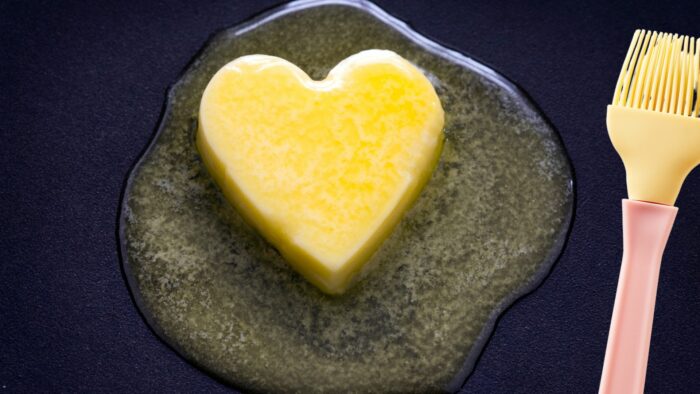Last Updated on February 9, 2023
You might have heard some debate about using egg wash vs butter when baking. When it comes to making bread, biscuits, scones, pastries, pie crusts, and other baked goods, a ‘wash’ is often used to give them a delicious exterior. However, not every type of wash can be used interchangeably, so it is important to know when you can use butter and when you should use egg.
Since baking is a science, different ingredients will have different effects on your baked goods. To ensure the best results on your favorite baked goods, you want to make sure you are using the right type of wash at the right time. Egg wash and butter are two of the most common types of washes but you can’t always substitute them for each other.
What Does A Wash Do On Baked Goods?
A wash typically consists of a coating of egg, butter, buttermilk, or milk that is added to a baked good typically before baking. Washes are generally added to baked goods before they go into the oven.
The most common foods that call for washes are baked goods such as include bread, biscuits, pastries, pie crusts, and scones. Typically they are added to flaky baked goods to give them a glossy, golden brown color and a crispy or tender texture.
In most cases, washes are added to baked goods before baking them, but sometimes they are applied after coming out of the oven while still warm. A pastry brush is commonly used to apply washes to baked goods.
What’s egg wash?
Egg wash is the most common type of wash used for baked goods. It is typically an egg combined with a small amount of liquid, such as water, cream, or milk. However, sometimes just a beaten egg is used for egg wash.
Egg wash gives baked goods a shiny, golden appearance. It will create a crisp, golden-brown crust that tastes delicious and take your baked goods up a notch.
An egg wash will also seal in the flavor while helping prevent moisture from escaping. The protein in the egg white creates a protective barrier that seals in moisture while the yolk provides a beautiful brown coloring to the crust.
Typically, egg wash ingredients include one egg and one tablespoon of your liquid of choice such a water, milk, or cream. The egg and tablespoon of liquid are then beaten together until combined and then brushed on the food. Water is the most common liquid used though some people opt to add no liquid at all.
What’s butter wash?
Butter wash is another type of wash used in baking, though it is less common than egg wash. Butter wash typically consists of equal parts melted butter and milk.
After melting, the butter is cooled for a minute before combining the milk. Once combined, the butter wash is applied to the baked good with a pastry brush.
Butter washes are more common in recipes where the dough is dense, such as biscuits. It helps creates a nice golden brown exterior with a crispy texture. It also helps gives biscuits a delicious buttery flavor.
Butter wash is typically not used on more delicate doughs such as pastry dough. The butter can burn sometimes before the pastry is cooked.

Egg Wash Vs Butter: What Are The Differences?
While in some cases you can use egg wash and butter interchangeably, that is not always practical. While butter wash can have its advantages, egg wash is the more popular option.
Texture
Egg wash can provide a glossy, crispy texture. However, be careful to not add too much as it can cause a gummy texture on your baked goods if you add too thick of a layer.
Butter wash can provide a tender yet crispy texture to your baked goods. It also provides a golden brown color like egg wash but won’t provide a glossy appearance like egg wash. Butter can make your baked goods too greasy if you add too much.
Color
Egg wash and butter wash provide a similar golden brown finish to your baked goods. However, egg wash tends to provide a more uniform color than butter wash.
Preparation
Egg wash is easily made by combining a beaten egg with a tablespoon of water, milk, or cream. It is then added to your baked good before putting them in the oven.
Butter wash involves melting the butter and then letting it cool for a minute before adding milk. The butter wash is then applied to the baked goods before they go in the oven. In some cases, melted butter is applied to baked goods, such as bread, after they come out of the oven.
Flavor
Egg wash and butter wash generally enhance the flavor of your baked goods. In some cases, the butter wash will add a nice buttery flavor to your baked goods.
Cost
Typically, eggs are cheaper than butter. This makes egg wash the more budget-friendly option.
Can You Use Butter Instead Of Egg Wash?
If your recipe calls for egg wash, you generally want to stick with that. However, in a pinch, you can use butter wash as a replacement in most recipes but it is still best to stick with egg wash.
Should You Use Egg Wash Or Butter On Pie Crust?
It is always best to use an egg wash on your pie crusts. The egg wash will give your pie crust a shiny, golden brown appearance while also giving it a nice crispy exterior without over-browning.
Egg Wash Vs Butter: Deciding Which To Use
When it comes to baking, egg wash tends to be the more popular option. It provides a more uniform color than butter and there is less of a chance that it will over-brown. However, butter wash can still be a good option for certain recipes such as biscuits.
Do you have any questions regarding the differences between egg wash vs butter? If so, please ask your questions regarding using butter wash and egg wash in the comments.

Ever since she was a young girl, Anna has been a lover of desserts. As an adult, she enjoys
baking a variety of desserts from cakes, cookies, brownies, bread, and more from scratch. She
enjoys sharing her passion for baking with others who also have a sweet tooth. From properly
measuring ingredients to making sure they are the correct temperature, Anna knows the
importance small details can make in baking. She wants to share her experience with others in
hopes they can make the most delicious baked goods. When she’s not busy blogging, Anna
enjoys trying new recipes in the kitchen.


